How To Quickly De-Stem Herbs With A Kitchen Gadget You Already Own
Strip leaves from stems in seconds with the help of an unlikely tool.

Abbi Wilt
With every new day on the Internet comes an innovative kitchen hack I’ve admittedly never, ever considered. Each time an influencer shows me some out-of-the-box method to use a Microplane or microwaves garlic to demonstrate an easier peeling method, I’m faced with a smidge of imposter syndrome. If I were to total all of the seconds I could have saved with these tips and tricks, would they equal hours of wasted prep time? Inevitably, I turn on my once-trusted tools. Have I ever used a peeler correctly?
Upon total bombardment of everything from storing plastic wrap in the freezer to turning ordinary kitchen items into hyper-realistic cakes—hint: everything in those videos is cake—I have to let many of the trendy hacks pass me by. I simply cannot be expected to remember all thirty-six ways of cutting a watermelon. Maybe ignorance truly is bliss—some user’s off-the-cuff remark on cutting biscuits with a pint glass is temporary; my great-grandmother’s trusty biscuit cutter is forever.
The Viral "Box Grater" Method
When I first saw the viral herb hack video, which featured a TikTok user pulling cilantro through a box grater to remove leaves from stems (removing a stem is coined “de-stemming”), I was intrigued. I use my box grater for shredding many things, but I’ve not once considered using its individual metal holes as small blades. Another video showed the trick’s success with thyme on a grater with smaller holes. The leaves detached seamlessly from their stems. What? As a fresh herb aficionado who frequently uses up valuable recipe time pulling leaves from stems, I had to test out this unusual method for myself.
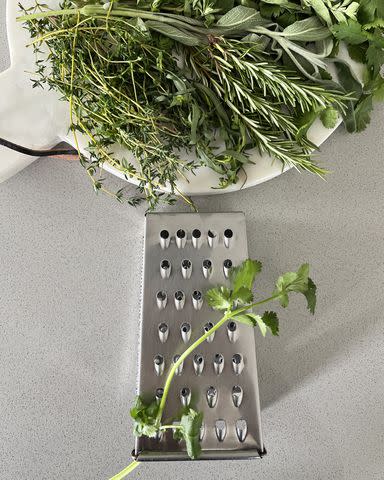
Abbi Wilt
I experimented with eight different varieties of herb, all varying in leaf and stem texture: rosemary, thyme, oregano, marjoram, tarragon, cilantro, mint, and sage. For each herb, I tested the effectiveness of three different sides of my box grater: the large shredding holes (think Cheddar cheese), the medium shredding holes (think shredded carrots), and the protruding, fine shredding holes—notoriously unfriendly to knuckles—which saw their very first use in my herb hack research (think finely grated Parmesan). The sides are labeled as large shred, medium shred, and fine shred in my results below.
How It Works With Different Herbs
Rosemary
With numerous, needle-like leaves, rosemary is by far my least-favorite herb to de-stem by hand. It also doesn’t lend itself well to a full-herb rough chop, as its woody stem—not unlike an actual twig—is hard to chew or enjoy. However, after pulling the rosemary through my box grater, this herb de-stemming hack will forever live in my repertoire of genius food prep hacks.
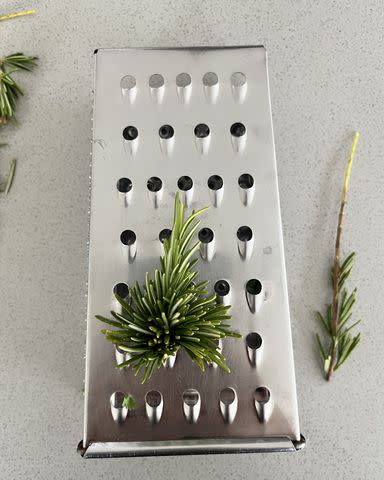
Abbi Wilt
Did the hack work? Yes! On the large shred, a single stem was easy to pull through and stripped the rosemary of almost all leaves. The medium and fine shred holes were both slightly too small for the width of the stem, leaving behind bits of stem membrane with the detached needles.
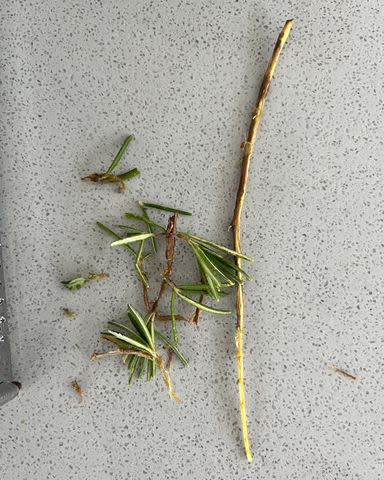
Abbi Wilt
Marjoram
Marjoram is often lumped together with oregano, but the plant has a more delicate, mild flavor, and thicker stem.
Did the hack work? Yes! Score one for the fine shred, which pulled all of the leaves off completely. The stem was almost too large to fit in the holes of the medium shred—if threading an herb stem through a small hole doesn’t save time, our hack is rendered moot—and the end result left several attached leaves. The large shred worked okay, but the bottom of each marjoram leaf was broken off instead of detaching directly at the base.
Thyme
TikTok made this herb hack look easy-breezy with sprigs of thyme. Thyme has tiny leaves attached to a sturdy, albeit thin, stem. It’s an herb whose leaves should definitely be removed, as pieces of its stem don’t fare well in your favorite soup.

Abbi Wilt
Did the hack work? Yes…ish. The medium shred removed almost all of the leaves perfectly, with just a few small “branch” pieces remaining at the top. The large shred was too big; the sprig pulled through intact. The fine shred broke up pieces of thyme’s thin stem, yielding the same result as if you were to chop the herb whole.

Abbi Wilt
Tarragon
Tarragon has a relatively soft stem and leaves, so I wasn’t feeling quite so optimistic about coaxing it through a metal grater.
Did the hack work? No. The stem was almost too thick for the medium and fine shred holes, though too thin for the large. The de-stemming hack resulted in ripped leaves, left-behind stem membrane, and broken branch pieces. All in all, it’d be much quicker to run a pinched thumb and forefinger gently down the stem to remove tarragon leaves.
Oregano
Oregano has soft, fragrant leaves and a pliable yet firm stem that I also like to avoid when I’m adding fresh herbs to a recipe.

Abbi Wilt
Did the hack work? Yes! I scored the medium shred as a five-star de-stemming experience. It stripped all leaves without any stem membrane. The fine shred also worked, but it left a bit of stem at the top of the sprig. The large shred was again too large and didn’t disturb the leaves one bit.
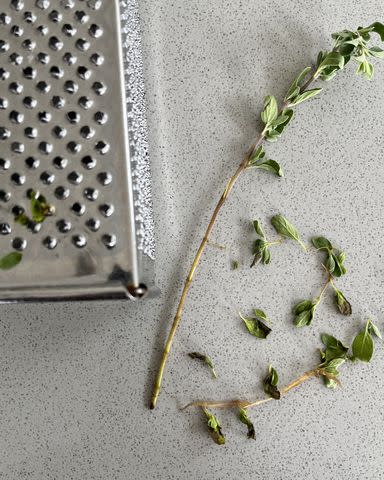
Abbi Wilt
Mint
Mint is another herb that becomes an integral part of my warm-weather kitchen routine. I use bunches of fresh mint in everything from mojitos to salads. A quick method of de-stemming mint would be a welcome tool in my apron pocket.
Did the hack work? Marginally. Stems were too large for the fine and medium shred holes, but did work in the large. However, leaves were ripped in half instead of pulled cleanly from their stems. Meaning: If you’re hoping to maintain the integrity of the mint leaf’s shape, as in a garnish, this may not be the hack for your mint crop. However, if you’re looking to muddle it all up in a mint julep, I encourage you to proceed (and raise my julep cup in solidarity).
Cilantro
Having witnessed the cinematic success of cilantro in the original video, I was excited to try out a whole bunch on my box grater. Cilantro is the herb most regularly used in my kitchen, both in frequency and quantity; a quick de-stemming could result in faster salsa (for me, motivation enough to try the hack).
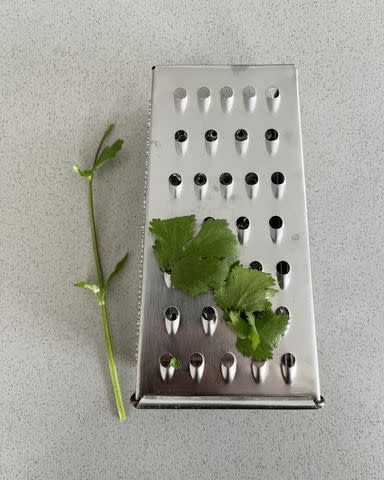
Abbi Wilt
Did the hack work? Sort of. The fine shred stripped all of the leaves from the stem, but it was difficult to thread through the holes. The stem was too large for the medium shred, and, surprisingly, the large shred didn’t work as well as I thought it would. A single stem pulled through unphased, while two stems as a bunch left some stripped leaves but residual broken stem pieces.
Sage
Sage doesn’t have many leaves on its thick, fuzzy stem to begin with, and, after seeing a few other stems leave behind membranes, I was unsure of our hack’s potential for success.
Did the hack work? Not well. Predictably, the stem was too large for both the fine and medium shred holes. The large shred did remove most leaves, but also ripped them. Bits of branch and stem were also left behind. My takeaway: It would’ve taken the same amount of time to pluck sage leaves individually off of their stem.
My Final Verdict
This innovative herb de-stemming trick with a box grater isn’t for every sprig of green in your garden—but when it works, it really works. Save time with rosemary, thyme, oregano, and marjoram, but stick to hand-pulling tarragon and sage. I leave cilantro and mint up to you.
Colander Vs. Metal Dinner Fork
To round out my research, I tried two related hack suggestions: de-stemming herbs using a colander and the tines of a metal dinner fork.
Metal Colander
A metal colander with circular holes will act similarly to the large- and medium-shred sides of your box grater. Unfortunately, my colander has slits for drainage instead of punched-out circles; the slits were too thin to accommodate nearly all of the stems. One added perk of using the colander method, however, is that your leaves are prepped and ready to rinse post-de-stemming.
Metal Fork
While the use of a metal fork sounds exceptionally convenient—a staple in most kitchens—I was disappointed with the results. Leaves detached sporadically from herbs with woodier stems, like rosemary, but almost every other sprig slipped right through the tines with leaves intact.
If you need me, I’ll be stripping herbs through a box grater for every fresh rosemary recipe I can get my hands on. May only the best kitchen hack videos come your way and may your table overflow with bright aromatics!
For more Southern Living news, make sure to sign up for our newsletter!
Read the original article on Southern Living.

